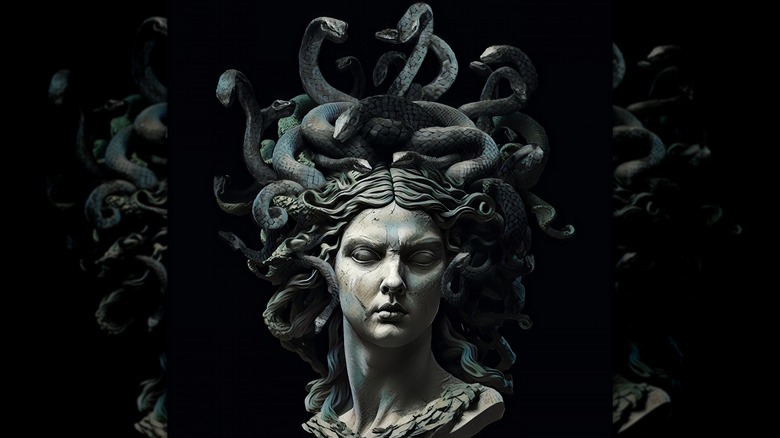Here's What Happened To Medusa's Sisters After Her Death In Greek Mythology
Greek mythology contains loads of memorable, standout characters, many of which have stood the test of time. Theseus, who with the help of the Minoan princess Ariadne, slayed the bull-headed, man-bodied minotaur and escaped from its underground labyrinth? Check. The hero Heracles (or Hercules to the Romans) whose first of 12 labors involves killing the invincible Namean lion? Check. Narcissus who fell so madly in love with his own reflection in a pool of water that he didn't eat or drink, but died and granted to us our word "narcissism"? Check. Zeus, Hera, Hades, Poseidon, Ares, Athena, Hermes, and many, many more gods live on, in a way, even if they aren't physically worshipped in temples anymore.
And then there's Medusa, arguably Greek mythology's most well-known figure. Even folks completely unfamiliar with Greek myth likely know the essentials: she had snakes for hair, her gaze turned people to stone, the dude who killed her (Perseus) used a shiny shield to see her and cut off her head, etc. This covers the basics. Folks might not realize, however, that Medusa was just the most famous of three monstrous sisters: the Gorgons. And while Medusa was mortal, her sisters Stheno and Euryale were immortal — they were also vastly more powerful. After Medusa died, they lived on. Some stories say that they traveled to the underworld to torment souls there, rather than stay above in the world of the living.
1 mortal sister among 3
Like all mythological tales, the story of the Gorgons underwent lots of changes over time, even long before they were ever written down. The three Gorgons were originally the offspring of two ancient sea monsters — Phorcys and Ceto — a brother-sister combo who birthed a whole bunch of horrifying creatures like the sailor-killing monster Skylla, the hundred-headed sea dragon Ladon, and more. Early descriptions depicted the Gorgons as winged women with tusks and brass hands, of all things. The whole snake-haired thing came later, as did Medusa's mortality and a revised origins story that differentiates her from her sister Gorgons, Stheno and Euryale.
The Collector explains that in one version of Medusa's revised origins story Medusa considered herself to be more beautiful than the goddess Athena, while in another version she was raped by the god Poseidon inside Athena's temple. Either way, Athena took her revenge on Medusa and made her into a Gorgon like Stheno and Euryale. Medusa, however, remained mortal. This is why King Polydectes dispatched the hero Perseus to behead Medusa and not her sisters.
With the help of Athena, Hades' helmet of invisibility, some winged sandals, and more, Perseus killed Medusa in her sleep. After that, the poet Hesiod in "Shield of Heracles" (via Tufts University) very vividly describes Stheno and Euryale chasing Perseus, who escaped with Medusa's head strapped to his back.
[Featured image by Peter Paul Rubens via Wikimedia Commons | Cropped and scaled]
Escaped to the underworld
As Greek Legends and Myths explains, not much is said about Medusa's fellow Gorgons, Stheno and Euryale, after Perseus completes his quest — it's Perseus' story, after all. Basically, the two characters up the stakes and make things more difficult for Perseus after he's beheaded Medusa. But as soon as Perseus escapes the Gorgons' lair, Stheno and Euryale don't pursue him further. It's a good thing, too, because The Collector says that Stheno was considered the most lethal of the three sisters and killed more people than the other two combined. Her name means "mighty" or "strong," while Euryale means "far springer" (far roamer) or possibly "of the wide briny sea" (per Theoi), and Medusa means "queen" or "guardian."
And what did Stheno and Euryale do after unsuccessfully chasing Perseus? We've got little to no information to go on except from the Roman poet Virgil, who mentioned the hero Aeneus seeing the Gorgons in the underworld his epic poem "The Aeneid," written from 30 to 19 B.C.E. Virgil wrote his poem, however, a good 600-plus years after Hesiod wrote the aforementioned "Shield of Heracles," as World History Encyclopedia tells us. It might have been a common story that Stheno and Euryale went to the underworld at some point after Medusa was killed, but we really don't know. If the two remaining Gorgons did go there, then remember: They're immortal. They'd be waiting there still.


